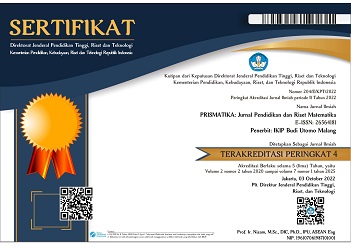KEMAMPUAN PEMECAHAN MASALAH SISWA DALAM MENYELESAIKAN SOAL HOTS (HIGHER ORDER THINKING SKILLS)
Abstract
This study aims to describe students' problem-solving abilities in solving HOTS questions for class XII MIPA MA Miftahul Ulum students on SPLTV material. The method used in this study is a qualitative descriptive method. After the research subjects have completed the problems given by the researchers, namely HOTS questions, the researchers will describe the results of these solutions based on indicators of problem-solving ability, namely 1) problem identification, 2) settlement planning. problem, 3) implementing the settlement plan, 4) and checking again. The research subjects taken were based on scores taken from the Odd Semester Final Assessment for the 2021-2022 academic year. The results of this study are that students' problem solving abilities are still relatively low because almost all students can only do two stages of problem solving, namely the stage of problem identification and implementation of a problem solving plan. Students still have difficulty in carrying out the planning stage of problem solving and the stage of checking again.
References
Avianty, Donna & Dyah Ayu Sulistyaning Cipta. 2018. Pengembangan Multimedia Interaktif Berbasis Masalah untuk Mendayagunakan Kemampuan Berpikir Tingkat Tinggi Pada Siswa Sekolah Dasar. AKSIOMA (Jurnal Pendidikan Matematika FKIP Univ. Muhammadiyah Metro), 7 (2), 237-242.
Darma, Y. & Firdaus, M. (2014). Kemampuan Pemecahan Masalah Matematis Siswa Aliyah Melalui Strategi Heuristik. Jurnal Pendidikan Informatika dan Sains, 3(1), 95-103.
Hewi, L., & Shaleh, M. (2020). Refleksi hasil PISA (the programme for international student assesment): upaya perbaikan bertumpu pada pendidikan anak usia dini. Jurnal Golden Age, 4(01), 30-41.
Keputusan Menteri Pendidikan, Kebudayaan, Riset dan Teknologi Republik Indonesia Nomor 371/M/2021 Tentang Program Sekolah Penggerak. 2021. Jakarta: diperbanyak oleh Muid, A.
Listiani, Welas & Yunis Sulistyorini. 2020. The Ability of Students as Teacher Candidates in Developing Higher Order Thinking Skills Mathematics Test. International Journal of Education and Research, 8 (9), 87-100.
Listiani, Welas & Yunis Sulistyorini. 2020.
Penyusunan Tes Matematika Berbasis High Order Thinking Skills. Prosiding Seminar Nasional IKIP Budi Utomo, 1(1), 76-83.
Masitoh, L.F., & Aedi (2020). Pengembangan instrumen asesmen Higher Order Thinking Skills (HOTS) matematika di SMP kelas VII. Jurnal Cendekia: Jurnal Pendidikan Matematika, 4(2), 886-897.
Ngongo, V. L., Hidayat, T., & Wiyanto, W. (2019, July). Pendidikan Di Era Digital. In Prosiding Seminar Nasional Program Pascasarjana Universitas PGRI Palembang.
Purwasi, Lucy Asri & Nur Fitiyana. 2020. Peningkatan Kemampuan Berpikir Tingkat Tinggi Siswa melalui Pembelajaran Matematika Berbantuan LKPD Berbasis HOTS. Jurnal Pendidikan Matematika: Judika Education, 3 (2), 65-74.
Subaidah, S., Valentino, E., & Wijayanti, E. (2017). Analisis Literasi Matematika Siswa Dalam Memecahkan Soal Matematika Pisa Konten Ruang Dan Bentuk. Buana Matematika: Jurnal Ilmiah Matematika Dan Pendidikan Matematika, 7(1), 7-12.
Sugiyono. 2019. Metode Penelitian Kuantitatif, Kualitatif, dan R&D. Bandung: Alfabeta.
Sulistyorini, Yunis, dkk. 2020. Profil Higher Order Thinking Skills Mahasiswa dalam Memecahkan Masalah Geometri. JRPM (Jurnal Review Pembelajaran Matematika), 5 (2), 87-97.
Ulva, M., & Amalia, R. (2020). Proses Pembelajaran Matematika Pada Anak Berkebutuhan Khusus (Autisme) di Sekolah Inklusif. Journal on Teacher Education, 1(2), 9-19.
Yazidah, Nok I, dkk. 2020. Pengembangan Soal HOTS pada Materi Aljabar. Delta-Pi: Jurnal Matematika dan Pendidikan Matematika, 9 (2), 68-78.







.png)




